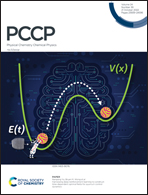BCC-Cu nanoparticles: from a transient to a stable allotrope by tuning size and reaction conditions†
Abstract
Metallic copper generally adopts an FCC structure. In this work, we detect highly unusual BCC-structured Cu nanoparticles as a transient intermediate during the H2 reduction of a CuI precursor, [Cu4OtBu4], grafted onto the surface of partially dehydroxylated silica. The Cu BCC structure, assigned by in situ Cu K-edge XANES and EXAFS, as well as in situ synchrotron PXRD, converts upon heating into the most commonly found FCC allotrope. DFT calculations show that the BCC-Cu phase is in fact predicted to be more stable for small particles, and that their stability increases at lower H2 concentrations. Using this knowledge, we show that it is possible to synthesize BCC-structured Cu nanoparticles as a stable allotrope by reduction of the same grafted precursor either in 10% H2 diluted in Ar or 100% H2 at low temperature.



 Please wait while we load your content...
Please wait while we load your content...